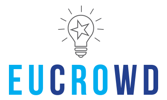EUCROWD project final report (pdf), March 2018
1) The impact of the project on the target group
The main impact of the project on target groups is improved awareness and better knowledge about crowdsourcing as an innovative e-participation method in national and EU level policy making process. According to the anonymous evaluation questionnaires answered by participants, the project increased their understanding of the EU decisionmaking and provided information on digital engagement tools available by the EU institutions. In particular, participants learned about best crowdsourcing tools helping citizens to have their voice in democratic politics and how they can use those platforms in their daily life. They also discussed and collected ideas on creating an on-line platform for crowdsourcing on the future of Europe. Many of the participants indicated that crowdsourcing was a new topic for them and that crowdsourcing has a lot of potential in the EU policy making. Some of them heard about the use of digital tools in decision making processes for the first time.
2) The achieved results
The project resulted in collecting EU citizens’ expectations and opinions on using crowdsourcing in policy-making at the EU level. Participants inputs were used for preparing recommendations on how citizens-crowdsourcing can support debate on the Future of Europe (following previous research). Knowledge gathered during the project was used for creating open access on-line repository on crowdsourcing. The project networked organisations and individuals from different EU countries in the field of citizens crowdsourcing aiming to advocate citizens oriented open government and digital democracy. This in turn helped to promote the concept of active European citizenship and improved conditions for democratic engagement at the EU level as the citizens engaged in the project are now better off to crowdsource public decisions and policies.
3) Results dissemination and visibility
Project visibility and results dissemination is enabled through project web site www.inepa.si/eucrowd, project brochure www.inepa.si/eucrowd/results/#Results, Twitter https://twitter.com/razprave_eu and Facebook profile www.facebook.com/evropske.razprave. Events organized have a dedicated sub-page including information about visibility www.inepa.si/eucrowd/results/#Reports. Each event had live Twitter (#eucrowd, Twitter moments) and Facebook coverage. Some events had created videos and visual material (banners, infographic) and enabled live stream. Dissemination of events took place through web sites, blogs, e-mailing lists, Eventbrite, Twitter, Facebook and Linkedin groups of project partners, related organisations and European networks in member states. Special attention was given to reach out young people and students. Five public media broadcasting reports were identified during project operation. Photos from the events are available at http://www.inepa.si/eucrowd/photos/.
4) The way the project responded to the programme multi-annual priorities
The project contributed to the programme multi-annual priorities by exploring crowdsourcing as a tool for a more democratic Europe in the following way:
- promoting debate on the Future of Europe by gathering opinions from citizens and civil society in various members states about the EU level crowdsourcing pilot as a part of inter-cultural engagement and networking;
- engaging young European citizens in co-defining a suitable crowdsourcing mechanism which would motivate them to get involved when discussing future EU policies. 43% of all participants attending project events we under the age of 30;
- increasing awareness of participants about e-participation tools available by the EU institutions and improving knowledge about best crowdsourcing tools helping citizens to have their voice in democratic politics;
- rising awareness among decision-makers on how crowdsourcing can efficiently support democratic debate on the future of the EU.
